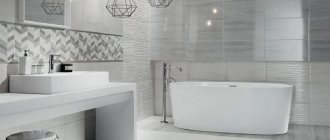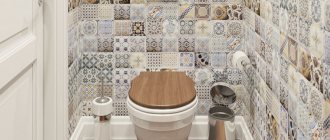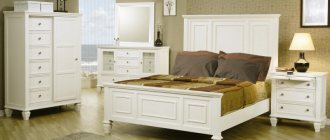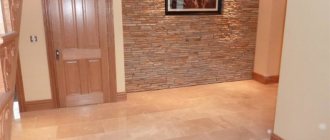Choosing ceramic tiles for bathrooms is not the easiest task. I want to do it beautifully, reliably and safely. Moreover, it is desirable that the tile lasts until the next renovation. However, the main difficulty of the task is that you have to choose quite rarely and therefore each time you have to figure it out from scratch. We tried to summarize in one article all the information that will help you choose ceramic tiles for the bathroom and toilet.
Types of tiles for the toilet
Ceramics are made in different sizes: from mosaics to large panels of 60x60 cm. The color palette can be monochromatic or with patterns and ornaments. Tiles in the toilet can create a panel or an entire picture using photo printing.
The shape of ceramic tiles in the bathroom can be different, ranging from the usual standard squares and rectangles to tiles with rounded edges. As a durable floor covering, you can use natural stone (marble, porcelain stoneware). And mirrored tiles or “hog” will look good on the walls.
How to choose the color of tiles in the bath?
You should not rely solely on your taste in this matter. Try to approach the issue objectively. Objective factors, such as the size of the room, will help you choose the right color of bathroom tiles. If the room is small, then you should abandon dark colors. Light shades will make the room visually larger and help solve the problem of lack of light. Nowadays, compositions made in beige and sand shades, pastel colors are in fashion. They fit perfectly with the white color characteristic of sanitary ware and furniture in bathrooms.
The use of bright colors, fruity shades and a sunny palette is allowed. Juicy green, crimson and various variations of red and orange. The popularity of marine themes, where azure and turquoise colors predominate, is not decreasing.
If you need to choose tiles for a large bathroom, then it is extremely difficult to choose a better combination than black tiles and gold. This option makes the room richer and brighter, but eats up a significant part of the size and few people can afford to adequately use this design option.
Tips for choosing
Wall finishing should not be done using floor tiles. This coating is too heavy. It simply will not stay on a vertical surface.
At the same time, light and fragile tiles should not be laid on the floor.
There is no need to buy frost-resistant tiles, since these properties are unlikely to be useful in the bathroom.
Before choosing tiles for the bathroom and toilet, you need to accurately determine its size and calculate the required number of fragments. Tile is a fairly fragile material. It is recommended to purchase it with a margin of 10-15%.
Repair experts give a number of tips regarding the quality of the coating. To ensure a long service life and maintain a pleasant appearance, you need to pay attention to the following parameters:
- Plane. The complexity of the process of finishing the walls of the toilet depends on this characteristic. To check the flatness, you need to place two tiles face to face. The narrower the gap between them, the better the plane. A distance of 1.5 mm is considered normal.
- Diagonal. The value is measured for several finishing elements using a tape measure. The smaller the difference in measurements, the better. Good toilet tiles should not be too different.
- Glaze. The glazed surface should be inspected against the light. This way you can see a network of small cracks. The fewer defects, the better.
Advantages and disadvantages of ceramic tiles for the bathroom
Tile as a facing material has many advantages. Its popularity is primarily due to its technical characteristics. It is also worth noting that it does not require special care, since dust and dirt do not linger on it. In order to clean the surface lined with ceramic tiles, it is enough to use a regular damp cloth or sponge and any detergent.
Tile is practical, environmentally friendly and easy to care for.
Another advantage of toilet tiles is their high environmental friendliness. It does not emit harmful chemicals and does not cause allergic reactions even in sensitive people. Ceramic is also a fire-resistant cladding material that is resistant to fungi and mold.
Helpful information! The service life of tiles is more than a dozen years. The strength of this material allows you to place household appliances and furniture elements on it.
The strength of the tile allows you to place household appliances and heavy furniture on it
Using ceramic cladding also has some disadvantages that you need to pay attention to before purchasing it. One of the main negative aspects is the cold surface. However, this disadvantage can be eliminated by laying tiles on top of the heated floor.
In addition to its advantages, tiles also have some disadvantages that are worth paying attention to.
The tiles do not have a good sound insulation coefficient. However, if desired, you can additionally lay materials on the floor and walls that will absorb sound. To install the tile itself, it is advisable to have construction skills and knowledge. Laying is carried out only on a perfectly flat surface.
To install tiles correctly, they must be laid on a perfectly flat surface.
It is recommended to calculate the number of tiles and select their design in advance, before installation. This will avoid troubles during installation. Experts also recommend studying photos of the tiles used for tiling the bathroom. This will allow you to visually assess the relevance of various design solutions.
DIY cladding
To finish the toilet floor with your own hands, you will need: tiles, glue, plastic crosses and wedges. To draw up any clear design idea, it is better to draw out the location of the tiles on a sheet of paper in advance.
Laying begins from the corner farthest from the entrance. The solution is applied using a notched trowel to the floor immediately before laying the tiles. Using a building level, you must ensure that the floor surface is free of distortions and unevenness. Plastic crosses are inserted on all sides of the laid tiles.
Choosing the color and shade of tiles for the toilet
For rooms with a small area, it is more appropriate to choose light shades, as they visually enlarge the space, filling it with light.
- An interesting combination would be a combination of two shades. This will help diversify the interior, making it more elegant and attractive.
- Shades such as white, cream, beige, soft pink and blue, muted yellow and light green look stylish and are suitable for rooms of any size.
- The effect of increasing space can be created by decorative elements or tiles placed vertically.
By listening to the recommendations of designers and masters on finishing a bathroom with tiles, you can independently make the right choice of both the material and the desired shade, which will certainly fill the room with beauty and give only positive emotions from the renovation.
Porcelain tiles in the bathroom
Unlike tiles, porcelain tiles are highly environmentally friendly - only a natural clay base and natural dyes are used in its production.
The moisture absorption capacity of porcelain stoneware is 100 times lower than that of tiles due to the high density of the material. Due to the absence of pores, it is maximally protected from fungus and destruction under the influence of moisture.
Porcelain tiles are suitable for cladding not only the floor, but also the walls in the toilet room.
For walls, it is recommended to choose glazed and polished options. They reflect light well, providing high-quality lighting and expanding space. Textured and matte varieties of porcelain stoneware are suitable as floor coverings - they have anti-slip properties.
Popular modifications of porcelain stoneware:
- marble imitation;
- classic white;
- red;
- combination of black and white;
- with wood texture.
Porcelain tiles will not be suitable only if the bathroom is already partially tiled with small-sized tiles. Against its background, the difference in textures of ceramics and porcelain stoneware will become obvious.
Thickness is also important
Floor tile dimensions include thickness. The standard thickness of floor tiles is from 6.5 mm to 11 mm.
Ceramic magnets have different thicknesses; options from 8 to 11 mm are in demand. Over 11 mm – tiles for laying in high-traffic areas. Thin tiles are easier to work with, they weigh less, and installation is not as labor-intensive.
A detailed story about the sizes and thicknesses of floor tiles in this video
Strength and durability depend not so much on the thickness of the product as on the correct installation.
Proper installation involves careful preparation of the surface and its leveling. There should be no voids during installation: glue is applied both to the base and to the tile itself. In this case, a ceramic magnet with a thickness of 8.6 mm can withstand a load of up to 200 kg per cm2.
What qualities should tiles for bathroom floors and walls have?
In order for the material to last as long as possible, you need to take into account its composition. To use wall tiles in the bathroom, it must have:
- Moisture resistance. This is important, since there may be sudden changes in temperature in the room, condensation may occur, and there is a possibility of splashes and leaks, which can lead to damage to the integrity of the material. The most resistant to moisture is ceramic granite.
- Resistant to chemical compounds. If you miss this nuance when choosing, you can ruin the material during the first treatment with detergents. With daily cleaning, the pattern will fade over time and the brightness of the main tone will decrease.
- High strength. It is necessary that the loads characteristic of a bathroom do not disturb the surface and quality of the material.
On a note!
The material for the walls can be chosen from an average cost, since such finishing plays a more decorative role.
In the case of floor tiles, the following conditions must be met:
- Chemical resistance. For the same reason as the wall one.
- Anti-slip coating. Since there is a risk of slipping, you need to choose a slightly embossed texture.
- Strength and stability. It lies on the floor under constant load, so a durable surface is needed so that any falling thing does not harm it.
Majolica or porcelain stoneware are good quality flooring options. The question also often arises of which tile to choose for the bathroom, matte or glossy. In this case, everything depends only on desire.
Tile size
Tile size in mm.
It is recommended to select the size of the tile depending on the design and area of the bathroom.
Large
A large tile is considered to be one in which at least one side is more than 40 cm long. It is used for finishing large bathrooms and floors.
Small
Small - have a size from 6 to 10-15 cm. They can be used to lay out repeating patterns, checkered patterns, “honeycombs”, etc.
Mosaic
Mosaic elements have a regular square shape. The side length can be from 1 to 5 cm.
For small bathrooms, it is recommended to choose medium tiles with a side of 15 to 30 cm. Large elements should be used only on the floor, and mosaics and patterns should be combined with neutral finishes.
If the bathroom area is large, you can choose any size and pattern.
Mosaic in the bathroom.
Combination and arrangement options
You can create an imitation of a panel on the toilet wall using tiles.
It is recommended to place tiles of dark shades in the area from the floor
In the upper part, a light color will visually expand the space. An interesting solution would also be a border made of decorative tiles.
Today there are waterproof wallpapers that can be placed at the top of the wall. Their surface cannot be damaged by moisture, because it is not absorbed. The contrast of the individual colors that are chosen for the coatings looks original. Considering the microclimate of the bathroom, it is recommended to opt for non-woven or vinyl wallpaper.
Proper, neat covering of walls and floors with tiles will give any bathroom a neat appearance
Designers advise using not only vertical, but also horizontal lines in the design of a given room.
Thanks to the right solution, it is possible to significantly increase the space.
Horizontal lines are not recommended for use in rooms with low ceilings. Visual distortion can be avoided. To do this, the design will need to combine vertical and horizontal lines.
The room will look much larger if rectangular tiles are mounted on the wall. It will need to be placed vertically. If there is a need to use decorative elements, they should always be at eye level. A combination of several colors of tiles at once looks impressive.
The combination of white and orange tiles in the design of a toilet
To visually enlarge a small room, it is recommended to decorate the walls and floor with mosaics. It is best to place tiles diagonally. The walls will stretch if the blocks are fastened in a horizontal direction. Minor use of horizontal patterns is allowed. If the room does not have a large layout, then the use of drawing should not be excessive.
Mosaic tiles in toilet design
Large formats are a great solution to the problem
Large floor tiles are always ceramic magnets, which are highly durable. In addition to the small format (16.5x16.5, as well as 20x20, 30x30, 33.3x33.3), there are floor tiles in large sizes.
size 60x60 cm
Floor tiles, having truly gigantic dimensions, are not without advantages.
- A practical choice when laying a large area. Ease of installation and beautiful appearance are the undeniable advantages of large-format tiles
- The stylish format can be used for original design solutions; it is used in different interior styles.
Such products have a rectified edge, due to which the seams will be almost invisible. To cover several square meters of floor you will need no more than a dozen tiles. The minimum gap and a small number of seams creates a feeling of solidity.
The large format is ideal for rooms designed in minimalist or high-tech styles. In such cases, maximum free space, simple and strict forms are required. Mosaic is excluded, and the semblance of a monolith with a restrained pattern looks impressive and even aristocratic.
Features of large format installation
When installing 20x20 or 30x30 tiles, you can ignore small unevenness. Minor protrusions are not encouraged, but are acceptable. Installation of 600x600 requires careful preparatory work; the deviation will be noticeable and can lead to deformation, cracks, and chips.
Wood imitation
Wooden flooring is always beautiful and stylish, but few people can afford high-quality parquet. Wooden floors need to be looked after; it is not recommended to use such a floor in rooms with high humidity.
Wood-imitating tiles are an excellent alternative and a worthy replacement.
To ensure that the tiles resemble floorboards or parquet as much as possible, the products have an oblong shape. The popular formats are: 15x45, 15x45, 15x60. The elongated shape makes the tile fragile, so a ceramic magnet is used. The size range is extensive: there are models whose width ranges from 110 to 250 mm, as well as lengths from 450 to 1500 mm. Thanks to the large selection, you can find products that qualitatively imitate parquet or solid wood. At the same time, the tile externally conveys the texture and color scheme of the wood covering.
The convenience and practicality of the product is that there is practically no waste, and the end result is a durable and beautiful coating. Imitation wood will fit into any interior and give the room a classic and even aristocratic look. It’s hard to think of a better tile for a hallway.
Often heated floors are installed in the hallway, corridor, bath and toilet. Ceramic magnet is excellent for tiling the floor of such rooms, so this option is beautiful, practical and economical.











